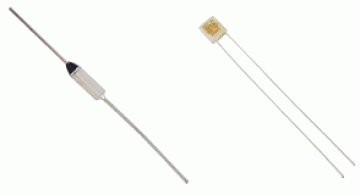THERMAL CUTOFFS

THERMAL FUSES 101
No matter what you call them, we have a broad line of axial lead and radial lead Thermal Cut-Offs, a.k.a. Thermal Fuses or TCO’s.
These are extremely popular items.
- Definition: A thermal fuse is a cutoff which uses a one-time fusible link. Unlike a thermal switch, or disc thermostat which may automatically reset itself when the temperature drops, the thermal fuse is more like an electrical fuse: a single-use device that cannot be reset and must be replaced when it fails or is triggered. A thermal fuse is typically used when the overheating is a result of a rare or safety related occurrence, such as failure of the temperature regulating circuit, requiring repair (which would also include replacing the TCO) or replacement at the end of service life. The active component of an axial lead thermal cutoff is an electrically insulated thermal pellet. This pellet holds a spring-loaded contact against a fixed contact under normal operating temperatures. When the preset temperature of the cutoff is reached, the pellet liquifies, the springs relax, and the spring-loaded contact is moved away from the fixed contact, opening the circuit. In the case of radial lead types, a fusible alloy melts at a preset temperature and creates an open circuit.· Typical Applications: Thermal fuses are usually found in heat-producing electrical equipment. They function as safety devices to disconnect the current to the heating element in case of a malfunction (such as a defective thermostat) that would otherwise allow the temperature to rise to dangerous levels, possibly starting a fire. Unlike electrical fuses or circuit breakers, thermal fuses only react to excessive temperature and not to excessive current (unless the excessive current is enough to cause the thermal fuse itself to heat up to the trigger temperature).
Some applications include:
-
- HVAC Equipment
- Battery Packs, Battery Chargers, and Power Supplies
- Transformers
- Heat Guns
- Small Home Appliances: Coffee Makers, Hair Dryers and Toasters
- Water Heaters, Dishwashers, Microwave Ovens, and Refrigerators
- Motors
- Proper Fuse selection: In replacement applications the selection of a properly rated thermal fuse is straight forward. Thermal fuses are usually marked with the opening temperature and/or part number.
In new design applications it is necessary to select a thermal fuse rating above the maximum temperature experienced by the thermal fuse during normal operation, including expected short-term temperature overshoots. The temperatures experienced by the thermal fuse during normal operation will determine the life expectancy of the thermal fuse. If the thermal fuse rating is too close to the temperature experienced during normal operation (including overshoot temperature after opening of a thermostat, etc.), the probability of a nuisance trip increases. Nuisance trips are caused by pellet shrinkage due to repeated operation at temperatures near but below the stated opening temperature. The design engineer must make the decision between response and life of the TCO based on product requirements. It is important to remember that temperatures experienced in actual application will vary from unit to unit.
AXIAL Style

RADIAL Style

- Storage Precautions: In some cases, low temperature TCO’s have been known to fail prematurely due to storage or transportation in high temperature areas. (think of a UPS truck sitting in the hot summer sun) The low temperature rated NTE8065 (rated for 66ºC/151ºF) can be particularly susceptible to excessive heat conditions.
- Soldering Leads: care must be taken that during the installation process the new fuse is not prematurely stressed by improper soldering, or damaged by excessive bending of the leads. Thermal fuse leads being soldered should be heat-sinked during the process. If excessive heat is conducted by the leads into the fuse pellet it can shorten its life. To facilitate this process we do have available crimp splices (P/N: TCO-SPLICE). These splices eliminate any potential damage caused by high soldering temperatures. PARALLEL NON-INSULATED SEAMLESS SPLICE FOR TCO .276 X.130 X. 094



 del.icio.us
del.icio.us Digg
Digg